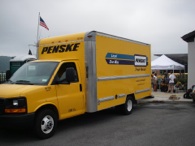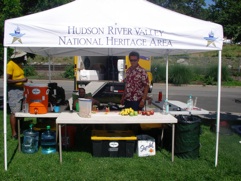The Great Hudson River Paddle (GHRP) 2008 ends today (Sunday, July 13th) when the paddlers launch from the Beczak Environmental Center in Yonkers to complete the last fourteen miles into Manhattan. The trip will end at the Downtown Boathouse on Pier 96.
Bruce and I left the group at Irvington on Friday, a short 21-miles from the city. It was clear enough that day to see the Manhattan skyline in the distance beyond the George Washington Bridge. With a push from the tide and current, that distance could be covered in three hours or less. So why not just continue? Why Scott Keller, Trails & Special Projects Coordinator, Hudson River Valley Greenway and our fearless leader on this trip. (This photo was taken in 2007, before Scott lost 50 pounds.) I am relying on Scott to correct any of my errors regarding GHRP history.
The GHRP was conceived and initiated in 2001 as a vehicle for publicizing the Hudson River Valley Greenway and the Hudson River National Heritage Corridor. Community events and celebrations are planned all up and down the navigable Hudson to coincide with the GHRP. Because the GHRP is primarily a vehicle to focus attention on the river, its communities and recreational possibilities, the paddling experience is sometimes less challenging that some paddlers might like. The day spent in traveling 7-miles from Irvington to Yonkers is a good example. All of the paddlers could do the whole 21-Dignitaries speaking at the Launch of this years GHRP
This means that there are several things that the GHRP is not. So for those of you who might be intrigued enough to consider joining a future GHRP, let me tell you what you can expect. First of all, this is not an unsupported, expedition type trip. It is heavily supported by the communities where we stop and by a mobile ground crew. The ground crew carries water, food and refreshments that are ready when we arrive at our next campsite. Each paddler is issued a standard size duffel into which he or she can put any clothing or gear they don’t want in their boat. These duffels are transported site to site by the land crew in their big Penske truck.
The GHRP is not a wilderness camping experience. While there are many wild stretches of the Hudson where Bald Eagles and Osprey soar overhead, the navigable Hudson is a 400-year-old transportation Mark shows Connie how to tie a figure eight knot at Chelsea.
The GHRP is not a laid back, “do-your-own-thing”, leisurely stroll down the river. There are typically 20 to 30 paddlers on the Kayaks parked at Cornell Park, New Baltimore
The four person boat carry.
The cocoon takes shape. Photo by L. Morelle
But the cocoon is also tiring; at least I find it so. It is difficult to zone out and get into your own paddling rhythm for more than a few minutes. You are constantly adjusting to the changing positions of boats around you. Also, there isn’t any ability to explore some interesting spot on your own. You must stay with the group and keep up the pace. Finally, once at your next campsite, all the boats come off the water and are not allowed back on until launch the next day. Theoretically, you can go out and paddle again if you can get a guide to accompany you. But in three years of paddling the GHRP, I have yet to see it happen.
Lunch break on the GHRP 2006
On the water we paddle in the cocoon, stopping for water every half-hour or so. If it’s hot we blast each other with supersoakers. We take a quick shore break every 90 minutes or so and a lunch break at noon, which will last 40 to 60 minutes. Once at camp we follow the landing protocol.
In our new camp, some folks (like me) scout out a good spot to set-up a tent and get right to it. Others go directly to the refreshment tent for Gatorade, fresh fruit or nuts. Sometimes there’s even iced coffee! Soon the shuttle arrives to take us to a remote location for showers (this is usually a school, but can also be a variety of other facilities). After we are cleaned up, its time to explore the town, or head off for a restaurant meal (as in Saugerties and Kingston), or a party (as in New Baltimore and Cold Spring). Sometimes there’s no town near by so we eat in camp (as in Chelsea and Stony Point). At sundown, the mosquitoes come out Johnny Miller has refreshments ready when we hit the beach!
This is what life is like day after day on the GHRP. Any two or three days of the trip are not a problem for most people. Keeping to this routine day after day for eleven days is draining on almost everyone. Even with all the support from the ground crew and guides, each paddler is paddling his or her partially loaded kayak over thirteen miles each day on average. Each one is setting up his or her tent and sleeping arrangements. Everyone breaks down and packs that same gear each morning, after sleeping outside, on the ground, in all kinds of weather. Sometimes the waiting induces boredom (a lot of books get read on this trip). Sometimes you tire of being constantly surrounded by people and just need to be alone. The cumulative effect of this is wearing and provides the major test of this adventure.
It is also amazing how many people are paddling with some sort of disability. There are the usual arthritic knees, bad backs, worn rotator cuffs, asthma; all of these things and more are present in the paddling group. But you’ll also find folks who’ve had knee or hip replacements. People with crippled legs, rheumatoid arthritis, and poor vision make the trip. Cancer survivors are common (one excellent paddler had a colostomy). These people are inspiring, as they pull their full weight and seldom complain.
Now you know a lot about what the Great Hudson River Paddle is and what it is not. You have some idea of what to expect. If you like to paddle, enjoy people and are comfortable camping, this is a trip you should consider. It is not expensive. It is a challenge and great fun (you could look at it as an eleven day floating party!). And you get to experience the grandeur and beauty of one of our country’s premiere rivers, the Hudson. After participating for three consecutive years I’ve made many friends and have gained some good paddling buddies. As with any adventure there are positives and negatives. But my experience has been overwhelmingly positive.
Video: Paddling Within the Cocoon
Link to GHRP Home Page: Great Hudson River Paddle
Return to GHRP Archive





























